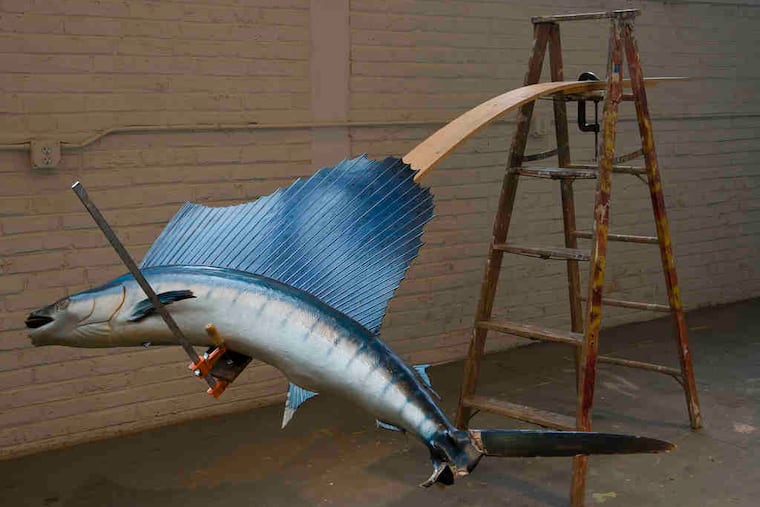Galleries: Fritz Dietel explores shapes of nature in paper sculptures
Fritz Dietel, a Philadelphia sculptor known for his exacting work in wood, is showing his efforts in handmade paper for the first time and inaugurating Schmidt Dean Gallery's new digs on Chestnut Street.

Fritz Dietel, a Philadelphia sculptor known for his exacting work in wood, is showing his efforts in handmade paper for the first time and inaugurating Schmidt Dean Gallery's new digs on Chestnut Street.
As he was in his 2007 show of wood sculptures, Dietel is still exploring shapes from nature, but he has narrowed his focus in this particular body of work to forms derived from flower buds, seed pods, sea sponges, and other objects whose inner structures are somewhat revealed through their exteriors. His transition from wood to abacá paper, made from pulped fiber extracted from the trunk of the banana tree Musa textilis, has enabled him to create a translucent, podlike skin over a hidden inner armature. (A 2007 Pew grant enabled Dietel to learn the art of papermaking).
When I think of Dietel's wood sculptures from four years ago, I think of perfectly finished pieces, not a cut out of place, and in some cases even overly finessed. Not so this time around. Dietel has allowed his paper pieces to suggest the distressing that weather, birds, and insects can exact on seedpods, buds, and berries, allowing the occasional tear or hole to remain exposed. It's hard for a perfectionist to allow nature in, one would think, and the artist clearly has decided to go with the flow.
A few of Dietel's more literal interpretations of nature in his last show of all-wood sculptures here veered into humor, referencing on occasion a cuckoo-clock kitsch. In this new paper work, however, he seems engaged in a more profound appreciation of nature and its naturally abstract patterns, and sculptures such as Chalice, a pink-tinged, puffed-up abacá pod emerging from a spiky mahogany base, and Smithsonian, a peach-stone shape encased in an open, netlike paper skin, bring to mind individual elements of Charles Burchfield's late, revelatory paintings rendered as three-dimensional, larger-than-life objects.
Big, hot mess
The messy, the gritty, and the awkward have the edge in contemporary art at this moment, or so it would overwhelmingly seem at Jolie Laide, whose "Dirt Don't Hurt" rounds up 18 artists of all ages with penchants for some or all of the above.
Joyce Pensato of New York, best known of the group, has been transmogrifying adorable Disney characters into their evil doppelgängers through bravado Franz Kline-ish, abstract expressionist-style painting for more than three decades. She sums up the show's theme succinctly in her drippy black-and-white painting of a huge, distraught Minnie or Mickey Mouse face, The KKK Took My Baby Away, while David Brooks' found-object sculpture involving an altered plaster sailfish, a ladder, and clamps speaks nicely for the sculpture contingent.
One of the scruffiest works is a small painting by skateboarder-turned-filmmaker Harmony Korine, while Brendan Cass' large, horizontal, multicolored stripe painting, reminiscent of batik and Peter Doig, is too eye-poppingly gorgeous for this company.
Small and fine
Possible Projects, possibly Philadelphia's smallest gallery - in Fishtown, just a few blocks west of the Delaware River - has one of the most eloquent shows here this month, of sculptures by New York-based, Canadian-born artist Elaine Cameron-Weir.
The gallery space, a former butcher shop overlooking the intersection of Thompson and Norris Streets, has only four of Cameron-Weir's sculptures, but the hexagonal room, with its two enormous shop windows and its battleship gray-painted plywood floor, makes for a stringent, poetic display.
Known for incorporating scent (including perfume) into her works, Cameron-Weir has only one such piece here, 100 (2011), a long steel bar rolled in tobacco and propped against a wall. The shredded leaves exude an aromatic punch in this otherwise spartan show. An untitled piece, also from this year, comprises a rectangle of indigo-dyed silk stapled to the wall, with narrow sections of brass cylinders arranged atop it on pins to suggest patterns of constellations. Two black, square floor pieces from 2009 - Plinth 1, of shiny black glazed ceramic, and Plinth II, of black glass - arranged side by side, complete her minimal show. Seeing these quiet, magnetic, meticulously made pieces together in such a spare installation, it was hard not to think of the late Philadelphia sculptors Bill Walton and Charles Fahlen.